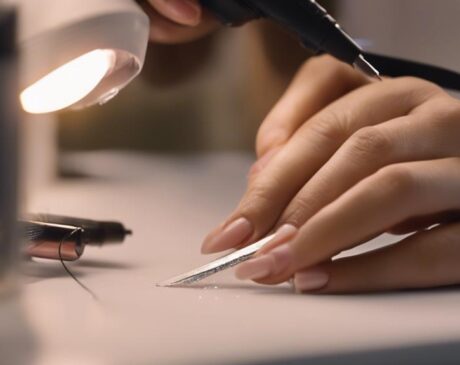Does Gorilla Glue Work on Wood?
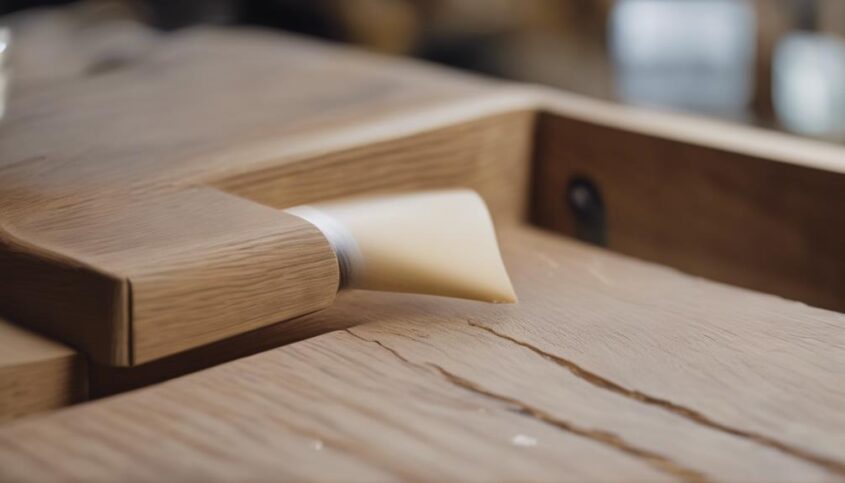
Gorilla Glue is an excellent choice for wood bonding, utilizing a polyurethane-based formula that provides strong adhesion on various wood types. Its expansion properties help fill wood pores effectively. Factors like surface cleanliness, temperature, and wood type impact adhesion. Proper application techniques and clamping ensure durable bonds. Gorilla Glue offers waterproof and weather-resistant qualities suitable for indoor and outdoor wood projects. Successful wood bonding requires surface prep, ideal glue selection, and proper clamping pressure. Discover more about the benefits and tips for using Gorilla Glue on wood surfaces.
Key Takeaways
- Gorilla Glue works on wood, bonding effectively due to its polyurethane formula.
- It expands into wood pores, ensuring strong adhesion on various wood surfaces.
- Suitable for hardwoods, softwoods, plywood, and MDF, demonstrating superior bonding capabilities.
- Waterproof and weather-resistant properties make it ideal for indoor and outdoor wood projects.
- Proper surface preparation, glue selection, clamping pressure, and optimal conditions ensure successful wood bonding.
Gorilla Glue: An Overview
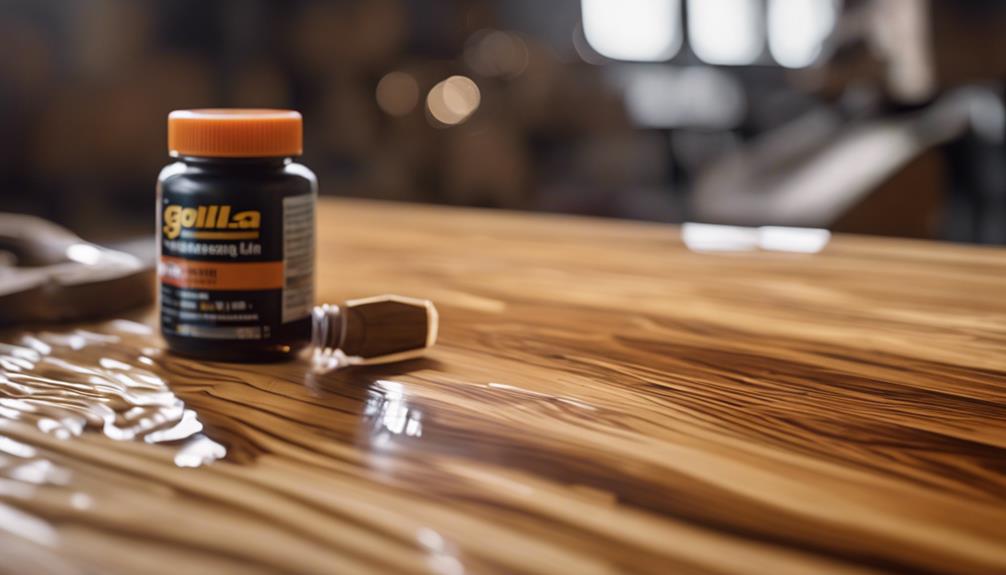
Gorilla Glue, a versatile adhesive known for its strength and durability, has gained popularity for its effectiveness in various applications. This innovative polyurethane-based adhesive is renowned for its superior bonding capabilities across different materials, making it a top choice for both professional craftsmen and DIY enthusiasts alike. Gorilla Glue's ability to bond dissimilar surfaces such as wood, stone, metal, ceramic, and more sets it apart in the adhesive market.
One of the key features of Gorilla Glue is its expansion capability, allowing it to penetrate porous surfaces effectively. This expansion plays a crucial role in creating strong and long-lasting bonds, making it ideal for a wide range of woodworking projects. Additionally, Gorilla Glue is moisture-activated, requiring a small amount of water to initiate the curing process, ensuring a reliable bond every time.
With its exceptional strength, versatility, and reliability, Gorilla Glue continues to be a go-to adhesive for those seeking high-performance bonding solutions in their innovative projects.
Types of Wood for Bonding
When it comes to bonding wood with Gorilla Glue, the type of wood chosen plays a crucial role in the overall effectiveness of the adhesive. Certain wood types, such as hardwoods like oak and maple, tend to bond well with Gorilla Glue due to their dense and durable nature. To achieve optimal results when bonding wood using Gorilla Glue, it is essential to consider the specific characteristics of the wood being used and follow recommended wood bonding tips.
Best Wood Types
Among the various wood types suitable for bonding, selecting the right kind is essential to ensure strong and lasting adhesion. When considering the best wood types for bonding with Gorilla Glue, innovation and quality are paramount. Here are four types that are known for their exceptional bonding properties:
- Oak: Renowned for its strength and durability, oak provides a solid foundation for adhesive bonds.
- Maple: With its smooth texture and tight grain, maple offers a reliable surface for strong adhesion.
- Walnut: The rich color and density of walnut wood make it an excellent choice for bonding projects.
- Cherry: Known for its beauty and workability, cherry wood ensures a visually appealing and sturdy bond.
Gorilla Glue Effectiveness
What factors contribute to the effectiveness of Gorilla Glue when bonding different types of wood? When it comes to bonding different types of wood, the effectiveness of Gorilla Glue can vary based on several key factors. The porosity and density of the wood play a significant role in determining how well the glue will adhere. Woods with open grains, such as oak or mahogany, may bond more effectively with Gorilla Glue compared to tighter-grained woods like maple or cherry. Additionally, the moisture content of the wood can impact the bonding strength, as Gorilla Glue requires some moisture to cure properly. Understanding these factors and selecting the appropriate wood types can help maximize the effectiveness of Gorilla Glue when bonding different types of wood.
Wood Bonding Tips
Selecting the appropriate wood species is crucial for achieving successful bonding when using Gorilla Glue. Different types of wood have varying characteristics that can affect how well they bond with adhesives. To ensure a strong and durable bond, consider the following tips when choosing wood for bonding:
- Choose Hardwoods: Hardwoods like oak, maple, and walnut are dense and provide a strong surface for bonding.
- Avoid Oily Woods: Woods with high oil content, such as teak or rosewood, can interfere with the adhesive bond.
- Prepare the Surface: Sand the wood surface to create a rough texture that promotes better adhesion.
- Use Dry Wood: Ensure the wood is properly dried to prevent moisture from compromising the bond.
Factors Affecting Adhesion
Various factors play a crucial role in determining the adhesion of Gorilla Glue on wood surfaces. One key factor is surface preparation. For optimal adhesion, it is essential to ensure that the wood surface is clean, dry, and free of any contaminants like dust, oil, or grease. Properly sanding the wood surface can also improve adhesion by creating a rougher texture for the glue to grip onto.
Another significant factor is the environment in which the glue is applied. Temperature and humidity levels can impact the curing process of Gorilla Glue. Ideally, the application should take place in a controlled environment with moderate temperature and humidity to facilitate proper bonding.
Furthermore, the type of wood being bonded can affect adhesion. Some woods, like oak or cedar, have natural oils that can hinder the adhesive bond. In such cases, it may be necessary to use a primer or sand the surface more aggressively to promote adhesion. By considering these factors, you can enhance the effectiveness of Gorilla Glue when bonding wood surfaces.
Application Techniques for Wood
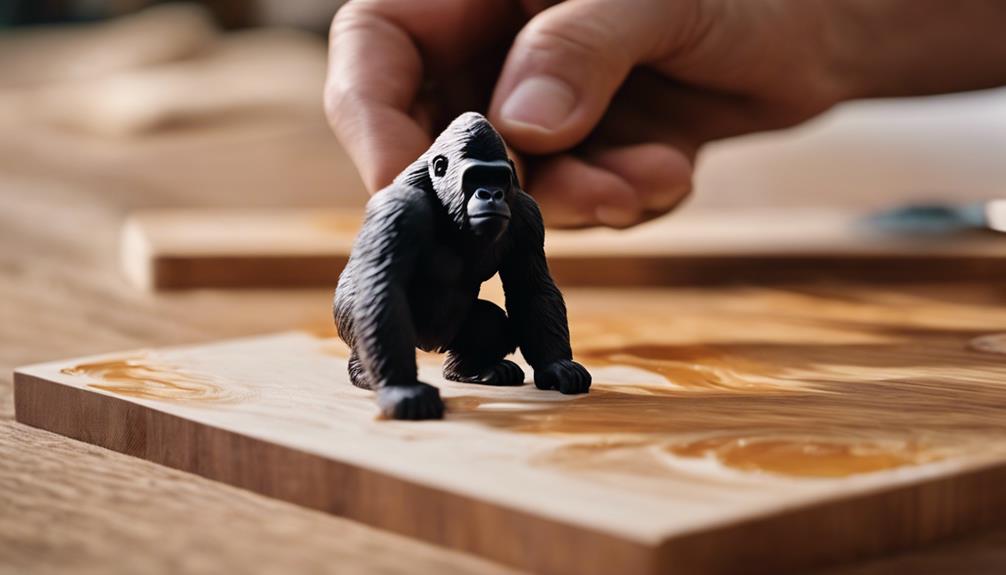
Exploring the best practices for working with Gorilla Glue on wood involves understanding key application techniques. Surface preparation tips, proper glue application, and effective clamping techniques are crucial for achieving strong and durable bonds in woodworking projects. Mastering these aspects can significantly enhance the adhesion quality and overall success of using Gorilla Glue on wood.
Surface Preparation Tips
Before applying Gorilla Glue on wood, what key surface preparation tips should be considered for optimal results? To ensure a successful bond, follow these innovative surface preparation techniques:
- Clean the Surface: Remove any dust, dirt, or debris from the wood to allow the glue to adhere effectively.
- Sand the Surface: Roughen the wood surface with sandpaper to create more surface area for the glue to grip onto.
- Dry the Surface: Ensure the wood is completely dry before applying the glue to prevent any moisture interference with the bonding process.
- Apply Primer (Optional): Consider using a wood primer to further enhance the adhesion of the Gorilla Glue for a stronger and more durable bond.
Proper Glue Application
For optimal results when applying Gorilla Glue on wood, employing proper glue application techniques is essential. To begin, ensure that the wood surfaces are clean, dry, and free of any dust or debris. Apply a thin, even layer of Gorilla Glue to one of the surfaces using a brush, roller, or nozzle, depending on the project's requirements. It is crucial to remember that Gorilla Glue expands as it cures, so only a small amount of glue is necessary. Once the glue is applied, quickly join the surfaces together and secure them in place. Proper application techniques not only enhance the bond strength but also promote a clean and professional finish for your woodworking projects.
Clamping Techniques
To ensure a strong and durable bond when using Gorilla Glue on wood, employing effective clamping techniques is vital during the application process. When clamping wood pieces together with Gorilla Glue, consider the following innovative techniques:
- Even Pressure: Apply consistent pressure across the glued surfaces to promote a uniform bond.
- Proper Alignment: Ensure the wood pieces are correctly aligned before clamping to prevent misalignment issues.
- Time Management: Allow sufficient time for the glue to cure while under pressure, enhancing bond strength.
- Cleanup: Remove excess glue immediately to prevent hardened residue that can affect the final finish.
Testing Gorilla Glue on Wood
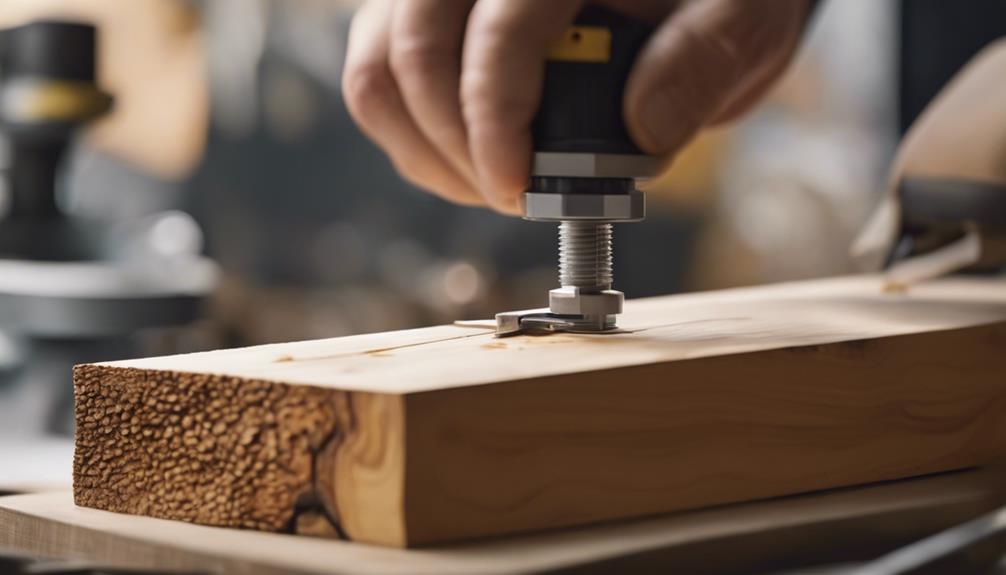
How effective is Gorilla Glue when used on wood surfaces? Gorilla Glue is renowned for its strong and durable bond, making it a popular choice for woodworkers and DIY enthusiasts. When testing Gorilla Glue on wood, it is essential to consider the type of wood being bonded, surface preparation, and application method. Gorilla Glue's polyurethane formula creates a powerful bond by expanding into the wood's pores, providing excellent adhesion and strength.
In comparative tests, Gorilla Glue has demonstrated superior bonding capabilities on various wood types, including hardwoods like oak and softwoods like pine. The glue's waterproof and weather-resistant properties make it ideal for both indoor and outdoor wood projects. Additionally, Gorilla Glue's versatility allows for bonding different wood surfaces, such as solid wood, plywood, and MDF, with exceptional results.
Tips for Successful Wood Bonding
When aiming for successful wood bonding, understanding the optimal application techniques and environmental conditions plays a pivotal role in achieving a durable and reliable bond. To ensure your wood bonding projects are a success, consider the following tips:
- Surface Preparation: Prior to bonding, make sure the wood surfaces are clean, dry, and free of any contaminants or finishes that could hinder adhesion.
- Proper Glue Selection: Choose the right type of adhesive based on the specific wood types being bonded and the intended use of the final product. Consider factors like open time and curing speed.
- Clamping Pressure: Apply adequate and uniform pressure while clamping to ensure that the adhesive spreads evenly and creates a strong bond.
- Optimal Temperature and Humidity: Work within the recommended temperature and humidity ranges specified by the adhesive manufacturer for optimal bonding conditions.
Frequently Asked Questions
Can Gorilla Glue Be Used on Outdoor Wooden Furniture?
Gorilla Glue is a versatile adhesive that bonds well with various materials, including wood. When used on outdoor wooden furniture, ensure surfaces are clean and dry for optimal adhesion. Gorilla Glue provides a strong and durable bond suitable for outdoor conditions.
Is Gorilla Glue Suitable for Bonding Two Different Types of Wood Together?
When seeking innovative wood bonding solutions, Gorilla Glue excels in uniting different wood types. Its exceptional strength and versatility make it a top choice for creating durable and long-lasting bonds between varying wood materials.
Does Gorilla Glue Work on Wood That Has Been Previously Treated or Painted?
When considering the application of adhesive to treated or painted wood surfaces, it is essential to assess the compatibility of Gorilla Glue. Understanding its adherence properties to such substrates can influence project success.
How Long Should I Wait Before Handling Wood Bonded With Gorilla Glue?
When working with wood bonded with Gorilla Glue, allow ample time for the adhesive to cure properly before handling. This duration can vary depending on factors like temperature and humidity, typically ranging from 1 to 24 hours.
Can Gorilla Glue Be Sanded or Painted Over Once It Has Dried on Wood?
Innovatively, once Gorilla Glue dries on wood, it can be sanded and painted over. Ensure thorough drying to achieve optimal results. Sand gently to avoid damaging the surface, then proceed with painting for a polished finish.

